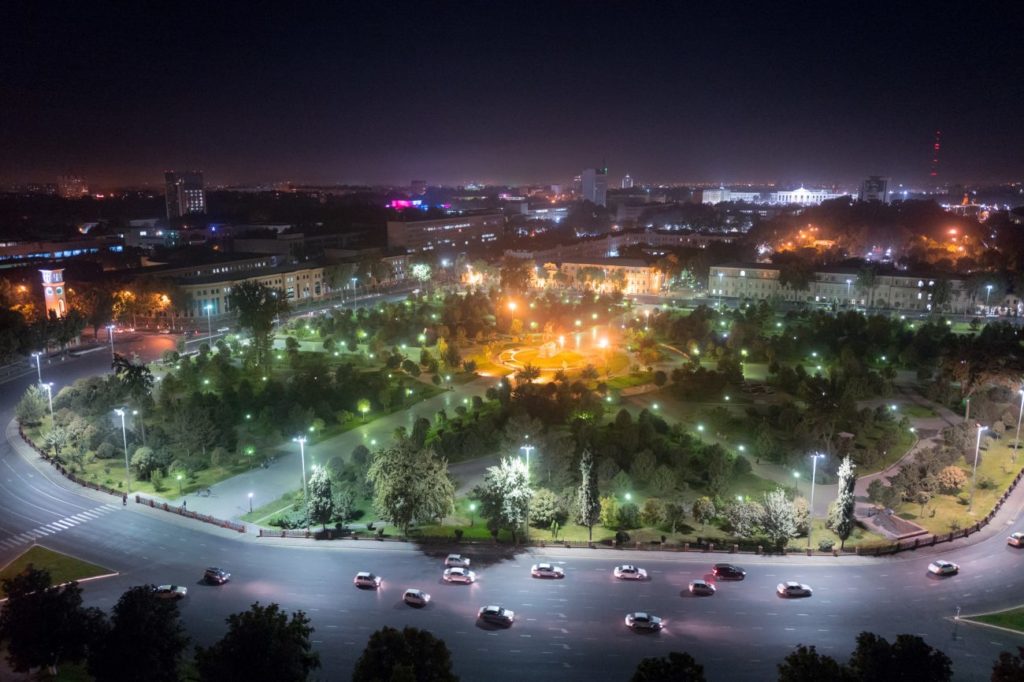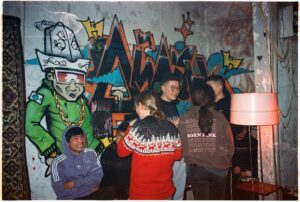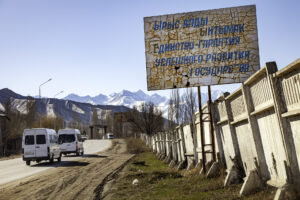Around 30 participants gathered on 20 November the year before last to discuss facets of Central Asian urbanity as part of the online event “The Future of the Past – Urbanity in Central Asia: Tashkent and Bishkek”.This article was originally published on Novastan’s German website on December 15, 2020. Perspectives on the future, living in the past? This is the impression often given by the streets of Central Asian capitals. Alongside prefabricated concrete buildings in various states of disrepair are residential areas consisting of private houses organised around courtyards adorned with fruit trees, in which community life is organised according to traditional patriarchal rules. Standing out from these are extravagant futuristic buildings both from the past as well as the present. Around 30 participants gathered online on November 20, 2020 in order to discuss these facets of Central Asian urbanity. Moderated by Phillip Schroeder (Novastan; University of Göttingen), the two-hour event began with introductory lectures from Maria Petrova (TU Darmstadt) on Tashkent and David Leupold (Leibnitz-Zentrum Moderner Orient, Berlin) on Bishkek (The planned lecture by Kishimjan Osmonova from Berlin on Astana was unfortunately cancelled due to illness). Both speakers focused on the lasting impact of Soviet housing and construction projects, contrasting references to the past and the future, and their associated divisions and conflicts. These divisions differentiate apparent ‘backwardness’ from ‘modernity,’ and arose both because of state or public sector initiatives as well as the resistance of certain sections of society.
Many of the apartment buildings which still stand today date to the era of Nikita Khrushchev (1953-64). In contrast to the Stalin period, the Soviet government under Khrushchev focused on the consumption needs of its citizens. Both speakers agreed that this period was marked by the construction of many apartment buildings across the USSR, which allowed for a certain degree of homeliness. Rather unsightly, but often praised nostalgically, the so-called ‘Khrushchyovkas’ also serve as a material basis for normality in Central Asia, and for shared experiences and affections across national borders. They were, as David Leupold put it, “less a concrete nightmare of grey monotony or a monument to totalitarianism […] but rather a place for real interactions, intimacy, and also comfort.” Typically, they were arranged into ‘microraions’ (large housing estates) with neighbourhoods in which daily life was to be organised. The ‘Khrushchyovkas’ also integrated Central Asia into the Soviet Union architecturally, and replaced the short-lived, pompous neoclassical architecture typical of the Stalinist period. As a result, in Tashkent today both (old) private houses and “multi-storey living” (Maria Petrova) coexist – or even clash – side by side. Read more on Novastan: Kyrgyzstan: Poverty hides behind Bishkek’s smog
Building Soviet modernity
Through the neoclassicism of the Stalin period in Tashkent, as well as the reorganisation of Bishkek, Stalinist fantasies of absolute power were expressed architecturally. While Bishkek was laid out like a chessboard, Tashkent was touted to become the showcase capital of Central Asia, as Maria Petrova explained. The centrally planned construction projects, incorporating classically reworked elements of Oriental style, were accompanied by the demolition of the old town, which in the eyes of Soviet leaders symbolised the region’s alleged backwardness and local way of life. With the arrival of refugees during the Second World War this construction phase came to an end, as all resources were being sent to the front while the condition of local housing deteriorated. Alongside Stalinist neoclassicism, Khrushchev’s tower blocks, and the attempts to earthquake-proof Bishkek, Soviet visions of the future – visualised by David Leupold using propaganda comics – reveal Central Asian (capital) cities to be experimental spaces. These spaces allowed for the creation of a Soviet modernity; city planners were able to realise their ideas almost ex nihilo. The traces of these bygone Soviet visions can be found today, side-by-side with current modernist projects – sometimes even on top of one another, turning the city into a palimpsest. At the same time, it is evident that ‘the’ past became and remains a mobilising force: whether through the notion that the past is a void waiting to be filled, or that physical relics of the past need to be destroyed; or through the construction of roads or earthquake defences; or the evocation of the past to express an expectation for new infrastructure. Read more on Novastan: Uzbekistan: Total Eren’s solar plant fully funded
Looking to the present and future
Some present conflicts therefore seem to be a repetition of history, as Maria Petrova argues in the case of Tashkent. The fusion of economic and state actors (partly a result of corruption) makes it difficult to oppose new construction projects, which are driven forward without the participation of local residents. Political decisions – for example, the complication of the registration process for NGOs – isolate and disempower the population. At the same time, past developments can benefit civil resistance. Residents have fared best in their confrontations with the authorities where they have been able to make contacts, organise, and build communities in their Khrushchevkas and the courtyards connecting them. Both speakers agreed that Khrushchev’s housing policy brought about positive changes, even if the results seem unappealing from the outside. On the one hand, affordable housing became accessible to the masses – even if the extent of the state’s involvement in providing infrastructure remained controversial. On the other, this housing offered the war- and terror-ravaged Soviet population a safe refuge, which also served as the starting point for collective trade. Read more on Novastan: Talas and its people: life by a Central Asian river affected by climate change These developments from Central Asia provide some conclusions regarding socio-political disputes in Western metropolises, even though citizens in the West have greater opportunities for recourse through the state. According to David Leupold, the universality of the (construction) process can be assumed, as is proven not least by the Gropiusstadt housing estate in south-east Berlin. Moreover, it is true both of this and of other housing projects that the residents of such estates typically view them more positively than outsiders do. The prospects for successful resistance in heavily neoliberal cities, with their tendency towards segregation, are greater when the space to be defended has already been designed. Pure wastelands would have it harder. The following videos show the introductory lectures (in German) by David Leupold and Maria Petrova.
Kerstin Bischl Novastan.org
Translated from German by Lawrence Brown
Edited by Timur Khan
For more news and analysis from Central Asia, follow us on Twitter, Facebook, Telegram, Linkedin or Instagram.
 The Future of the Past – Urbanity in Central Asia: Tashkent and Bishkek
The Future of the Past – Urbanity in Central Asia: Tashkent and Bishkek 



